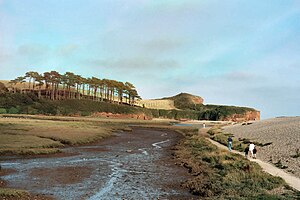River Otter
The River Otter is a river of eastern Devon. It rises in the Blackdown Hills just inside the county of Somerset, near Otterford, then flows south for some 20 miles through eastern Devon to the English Channel at the western end of Lyme Bay, part of the Jurassic Coast. The Permian and Triassic sandstone aquifer in the Otter Valley is one of Devon's largest groundwater sources, supplying drinking water to 200,000 people.
It gives its name to a number of villages on its course, the largest of which is Ottery St Mary.
Course
The river's source is north of Otterford, where a stream feeds the Otterhead Lakes and then through Churchstanton before entering Devon.
The river flows through a predominantly rural area, with small cattle, sheep and dairy farms. The largest town in the Otter Valley is Honiton. Tourism and leisure play important roles in the economy hereabout where hundreds of private cottages and farms offer B&B and rented holiday accommodation.
The river passes through or by Upottery, Rawridge, Monkton, Honiton (then below the A30 trunk road), Alfington, Ottery St Mary

At the Tumbling Weir at Ottery St Mary, water flows inwards over concentric circles, returning to the river by an underground tunnel.
Below Ottery St Mary, the Otter flows down to Tipton St John, Newton Poppleford and Otterton and finally reaches the coast to the east of Budleigh Salterton, after flowing through the 57-acre Otter Estuary Nature Reserve.
The point at which the river reaches the coast (SY073820) is part of the Jurassic Coast, a World Heritage Site.
The estuary
The Otter Estuary Nature Reserve is a landscape of tidal mudflats and saltmarsh, and it has been designated a Site of Special Scientific Interest.
There is no public access to the estuary itself but footpaths lead alongside with two viewing platforms on the west and two hides one on the west and one the east. The wintering population of wildfowl and waders includes redshank, greenshank, dunlin, common sandpiper, ringed plover, grey plover, curlew, snipe, water rail, wigeon, teal, shelduck, brent goose, red-breasted merganser and little grebe. Reed warbler, reed bunting and sedge warbler breed on the reserve.
On the course of the Otter
A small tributary is the River Tale, with the confluence northwest of Ottery St Mary. Another small tributary is Budleigh Brook, which joins the Otter at East Budleigh.
At Ottery St Mary the river is spanned by a 104 yards foot and cycle bridge named Coleridge Bridge; built at a cost approaching £1 million this was officially opened on 29 August 2011. A small area of land at one end of the bridge was sold to the local authorities by Lord Coleridge, a descendant of the poet, Samuel Taylor Coleridge.
At one time there were as many as fifty watermill powered by the River Otter. One remaining working mill, thought to date from the 17th century, is Tracey Mill near Honiton. In the 1970s, fish ponds were dug around the mill, fed by the leat; over a million gallons of fresh water flow though these ponds every day, helping the commercial production of trout without the need for antibiotics or added oxygen.
One mill, at Dotton, is known to have operated from around 1100 to 1960, after which the building was demolished. The site was excavated by Channel 4's Time Team, the programme The Domesday Mill being broadcast in 2007. This mill is mentioned in the Domesday Book. A weir diverted water to the mill's leat, supplying the vertical breast-shot wheel. Dotton (now little more than a farm) is four and a half miles above the mouth of the Otter, and about one mile north of the village of Colaton Raleigh.
At the picturesque village of Otterton (once a seaport on a larger Otter Estuary) there is a working watermill in this case over 1,000 years old; it was one of the three largest mills in Devon as recorded in the Domesday Book of 1086. It is powered by water diverted through a leat. Immediately north of the leat, a fish pass (or fish ladder) has been built beside a river-wide weir, restoring migratory fish runs to the river after a break of over 100 years.
Coleridge
The poet Samuel Taylor Coleridge (1772-1834), who was born in Ottery St Mary, wrote this poem entitled Sonnet to the River Otter.
Dear native brook! wild streamlet to the West!
How many various-fated years have past,
What happy, and what mournful hours since last
I skimmed the smooth thin stone along thy breast,
Numbering its light leaps! yet so deep imprest
Sink the sweet scenes of childhood, that mine eyes
I never shut amid the sunny ray,
But straight with all their tints thy waters rise,
Thy crossing plank, thy marge with willows grey,
And bedded sand that, veined with various dyes,
Gleamed through thy bright transparence! On my way,
Visions of childhood! oft have ye beguiled
Lone manhood's cares, yet waking fondest sighs:
Ah! that once more I were a careless child!


